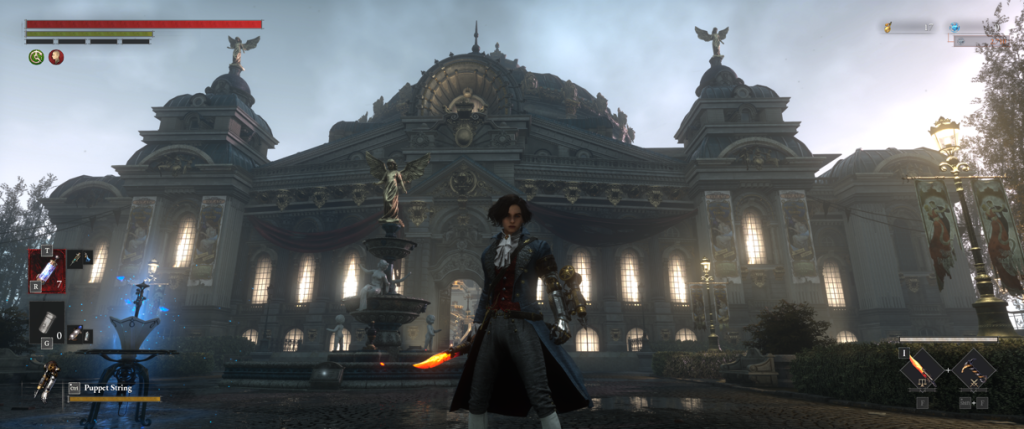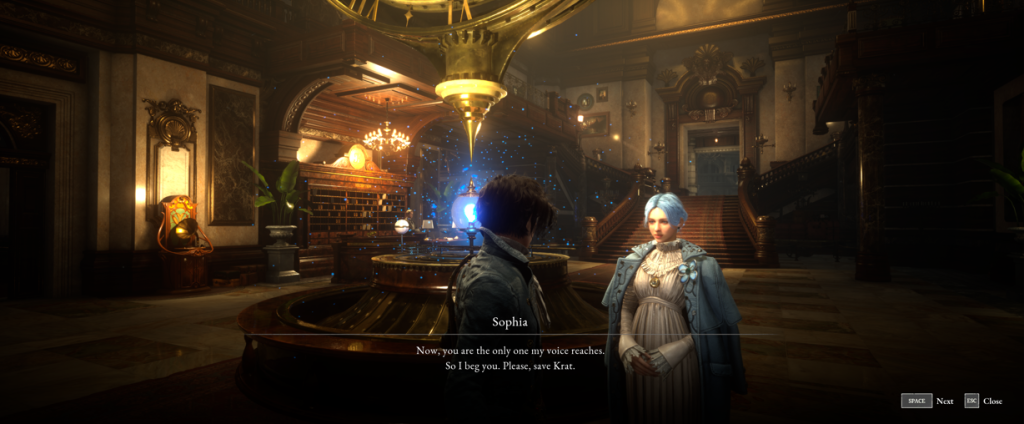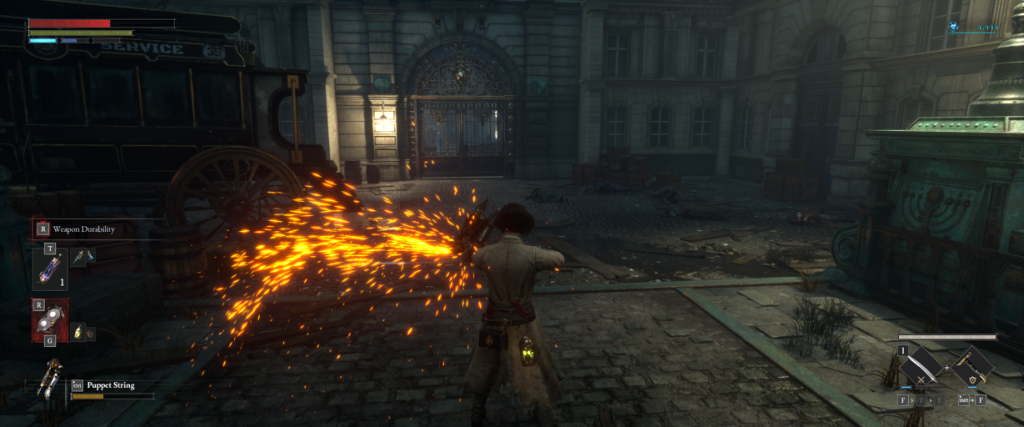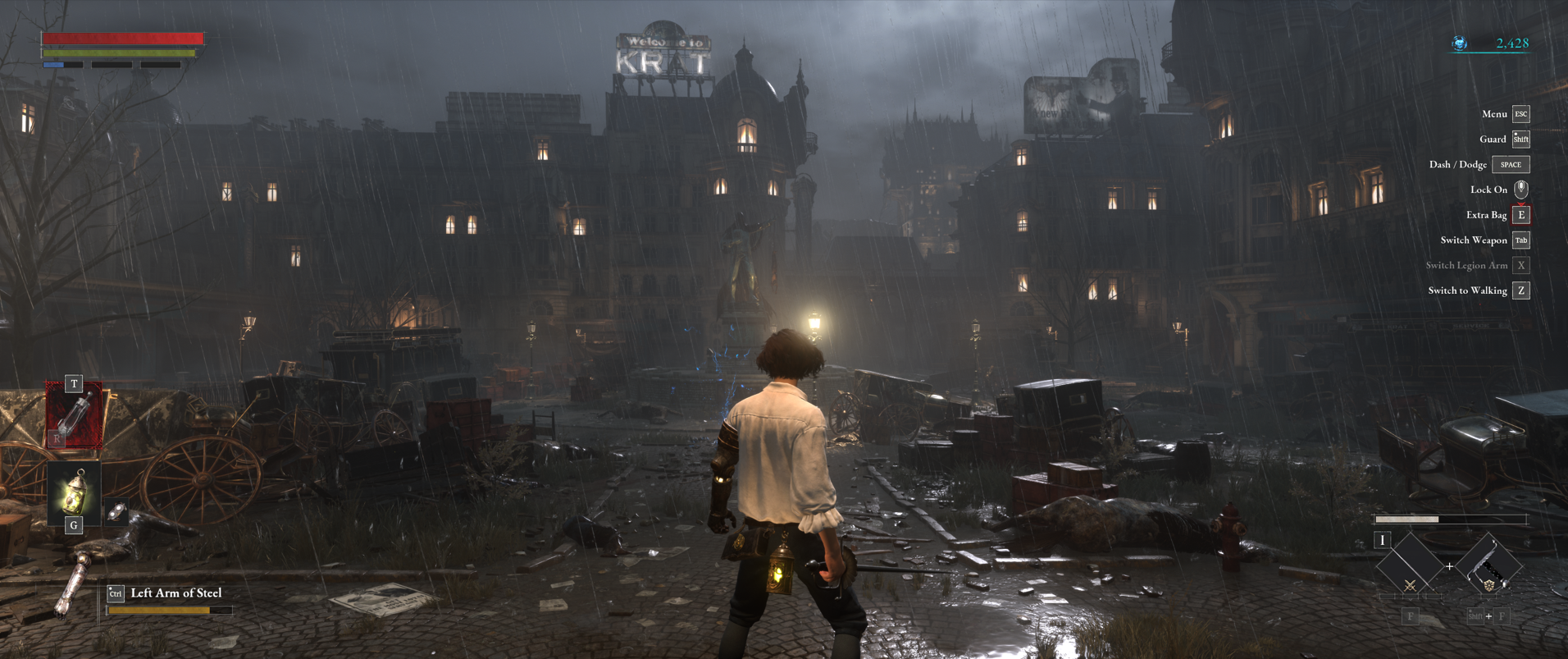Way back when I finished Yakuza 0, I started playing Lies of P. It was fun, then frustrating and that cycle continued for awhile. There were times I was stuck, constantly dying and thought I’d give it up. I’d then go back to “try one more time” only to spend a few more hours only to get stuck again.
I waited so long to write anything, because I wasn’t sure what I was even going to write. It went from planning on talking about how frustrated I was at the time to then wanting to express how glad I was I kept going. I’ve definitely settled more on the latter, but the frustration was real.
The City of Krat in Lies of P is Beautifully Dark

The first attention grabbing part of Lies of P is that the player character is an older, darker version of Pinocchio. His guide is an Ergo ghost name Gemini, stored inside of Monad’s Lamp (no idea what that is). Gemini makes a cricket-like sound, so I assume it’s a nod to the original fairytale’s, Jimini Cricket.
In this dark almost sequel to the classic fairytale, the action happens in the City of Krat. Ergo is the magical resource that allows Geppetto to build a legion of puppets to “help” the residents. There’s no surprise that it all goes terribly wrong.
A Puppet Frenzy turns the helpers into attackers, turning on the residents of Krat. The streets turn to graveyards all while a Petrification Disease takes hold of those not murdered by puppets. It also seemed like it was raining half of the time.
Almost everything was muddy and soaked with blood. It’s a very dark fantasy setting, but it all looks so good. Even in the darkness and death, Lies of P manages to paint a very beautiful picture. The graphics are impressive and environmental artwork is very well done.
The deranged puppets are scary to look at, but their artificial movement animations are so creepy. It’s very robotic and sometimes hard to time their movement. The sounds of metal parts moving also compliments the visuals.
Beyond the impressive presentation, the game is all about Pinocchio slashing through Krat to save human survivors.
Fighting the Frustration

I’ve never played Dark Souls or Elden Ring or any games like that. Going in, I knew I’d die a lot, but I was shocked just how much. It was very annoying how quickly the enemies right in the beginning could kill me.
What’s worse is, upon dying, I’d lose all my built up Ergo (game currency earned through kills) and have to start the level from the beginning. That restart also reset the enemies. I had to learn quick or I’d rage quit early.
Games like Lies of P are about balance, patience and preparation. Button mashing is a sure way to die quick. Once I learned to effectively block and counter attack, things flowed better. Adding well timed dodges in the mix also helped a lot.
What likely would have made the early hours much easier is if I spent more time perfecting guards. Some enemies are a cake walk once I could time Perfect Guards. When I strung enough of those together, I’d put the puppets (and later humans) into a staggered state.
This set me up for the a Fatal Attack, unleashing a ton of damage. Dodging, regular block and timing attacks took so much more time to down an enemy than using well time blocks to stagger them. Early on it was hard to time due to the strange puppet movements.
Lies of P Requires Balance
I had to learn to balance the actual attacks. Early on, I tried a lot of charged attacks and heavy attacks, but was punished for it. Those failures taught me about Stamina quickly. All my movements cost Stamina and the heavier the movement, the more it cost.
That’s where the balancing act came in again. I’d find spots to fit sever light attacks, then save the heavier stuff for when the enemy is stunned. As I started collecting better weapons and equipment, it became apparent balance is an issue there, as well.
I couldn’t just decide to choose the equipment with the highest stats, because those often weighed more. My character type was balanced between quick and strong, so newer, “better” equipment was not an automatic add due to weight.
Dying a lot is a big part of the game, but at least Pulse Charges are available to serve as health replenishment. I typically blew through those early on and later, learned to conserve them better. Getting far into an area with no charges left and dying was very anger inducing.
I’d have to fight my way back to the same spot to recover what Ergo was left after each hit I took deducts what is left for me to pick up from what I dropped on death. Lies of P does take pity on poor players like me though.
Risking Everything to Open Shortcuts
After making it far enough in the current location, there’s usually a way to double back and press a button to open a shortcut. I was always on the look out for those ladders, elevators and doors. It was such a relief to find one. I could get right back to my current location without fighting through everyone again.
Once I reached far enough, I’d be able to repair a Stargazer. I loved those machines because they served as a more solid checkpoint for the location. Upon dying, I’d respawn at that exact location. It was also a nice mobile camp of sorts where I could swap out equipment or teleport to other Stargazers.
That symbolic marker of progress helped me to keep going. The downside is that activating one resets all the enemies ahead. Not useful to double back to grab more stuff, but it was later useful for farming Ergo to buy upgrades and equipment. I could easily go back to an area I mastered and just collect.
It was a nice bit of revenge to go back to earlier areas with my higher level and equipment to just slaughter puppets that killed me multiple times.
Picking the Right Equipment to Have Fun in Lies of P

Learning how to block, dodge and time attacks perfectly is a way to play a game like Lies of P well. For the rest of us, non-perfect people, it’s all about choosing the right equipment. Due to the importance of balance in this game, it’s not as simple as choosing the equipment with the highest stats.
Finding the best equipment that also avoids weighing the character down is crucial. My build was not going to let me easily wield heavy items, so it took some trial and error. There’s a dizzying amount of equipment to tweak.
Weapon Variation
There’s plenty of different weapons, big and small, to purchase or find. There’s a ton I didn’t even try. I eventually settled on the Puppet Ripper for dealing with the frenzied puppets easily. The long reach and staggering damage helped a lot.
When it came to dealing with humanoid enemies, I trusted the Salamander Dagger. The fire damage it inflicts is great at burning that flesh. I used it so much, it was the first weapon I fully upgraded. It was key to a few human boss fights for me.
Each weapon is obviously upgradeable, but the handles are also swappable to create a “new” weapon. There’s a ton of variety this opens up. Each handle can also have it’s stats tweaked toward what’s important to the current build. I tried it here and there, but mostly stuck with the stock handle.
As if that wasn’t enough to worry about, weapon durability is also a thing. Luckily, they don’t break forever, but do require grinding to restore durability. I mean, they can get so bad they are basically useless, but activating a Stargazer repairs them.
With upgrade choices I made, I didn’t have a huge durability problem, but the game has instant repair kits in case I did.
Lies of P Amulets
I eventually found and equipped amulets. Moving toward the end game, I’d unlocked slots for up to 3. Again though, these things weigh you down, so I’d be selective with the 3. I settled on amulets that regenerated my HP and Stamina.
The third slot I’d swap out for what I need for the current situation. I think I racked up about a dozen, but there’s a few more I could buy. Again, a ton to experiment with.
P-Organ
Beyond using Ergo to upgrade my player stats, the P-Organ presented an upgrade tree of abilities. I ensured I acquired as many as I could to provide permanent benefits. There’s a ton of choices I made there I don’t even remember.
What I do remember is prioritizing the paths that would grant me more Pulse Charges, because one extra bar of health is essential. I also unlocked more spots for various equipment. Closer to the end levels, I could reset all those selections, but I didn’t want to break my build.
I didn’t want to build for something, only to find I’d deal with weaknesses I didn’t previously have the whole game.
Grindstones
The basic grindstone restores durability, but the more advanced ones provide special attributes. There was fire, shock, acid and more. When I’d fight with the Puppet Ripper, it was nice to apply the shock to really damage puppets.
Originally, the special grindstones only allow 1 use per trip through the Stargazer. I did upgrade mine to more than one use though. When I unlocked the Satisfaction and Perfection grindstones, it was super helpful to use more than once.
Satisfaction temporarily raised my critical damage to help me stagger enemies. The Perfection grindstone was true to it’s name. That temporary perfect guard ensured I didn’t need to nail the perfect timing of a block.
Cube Stones
The cube sort of reminded me of the on in Hellraiser. There’s over a dozen different stones to place inside. It’s another set of things to experiment with. More health, stamina and more. The health was obviously useful, but the star, for me, is the Friendship stone.
Most big boss fights had a vat outside to allow me to summon a Specter to fight alongside me. The Specter was great at taking attention away from me and providing extra hits. Since I let them take most of the damage, it was key for me to use the Friendship stone to heal them a bit.
I can guarantee that saved me a ton of frustration in some boss fights.
Defensive Parts
Right from the start, there are 3 layers of equipment experimentation specific to defense. Converters, Cartridges and Frames, added even more paths for trial and error experimentation. Beyond the weight considerations, I pretty much picked whatever would help me with current annoyances.
The annoyances that really stick out in my head are Shock, Disruption and Decay. If I didn’t have the parts to help reduce whichever of those I currently dealt with (killed a ton with), I made sure to get something.
Lies of P Throwables
I am not ashamed to admit I used Throwables to “cheese” some lower level bosses and at least one bigger boss. With some of the abominations I dealt with late game, it was almost essential to throw Thermite at them.
There were definitely a few times I bought Shock Canisters to exact revenge on bigger puppets that killed me. Overall though, I used them rarely in the first half of the game. For those that want to keep their distance though, there’s a decent variety.
Legion Arm
The Legion Arm is technically a piece of equipment, but also an essential part of the player character. I forgot there was even an attack button for it until I unlocked the Puppet String legion arm. That arm I used a lot. It’s ability to pull in enemies like Scorpion in Mortal Kombat was great to isolate enemies.
If 2 or more enemies came my way, I could snatch one and take them out before they all crowded me. When there were drop offs, it was also great to pull them over and watch them fall. Easy kill. I played around with the Shock and Flame variety arms, but constantly went back to Puppet String.
I eventually unlocked Falcon Eyes which was a nice Mega Man-like cannon arm. The range wasn’t very high, so not great for fast enemies. For slow ones though, the explosive shell was effective. I couldn’t pull bigger enemies toward me, so shooting them with explosives was a better option.
The real star of all the arms though is the Aegis. That big shield on the arm would redirect attack back at the enemy with explosive force. When I upgraded it fully, there was also an explosive counter attack I could utilize. It was also great when I could hold it up while still attacking.
That’s the thing with the Legion Arms too, a ton of variety to craft new ones or upgrade the current ones. More layers on layers of experimentation.
Adapting to the Lies of P Endgame

As if it’s not obvious already, Lies of P offers a ton of opportunity for different builds. It’s a very frustrating and annoying game at times, but the fun is in experimentation. In general, it’s not fun to die in game a lot. The key is learning something each time.
Each failure is a chance to get stronger, learn moves and swap out equipment. Quite a few times I convinced myself I wasn’t going to play the game anymore. Only hours later, I’d find myself trying out an idea for a build and take revenge on my previous stopping point.
There were stretches my build was so solid I’d cruise through a whole chapter with only a handful of deaths. Some boss fights I’d win on only the 2nd or 3rd try. There were even more that I spent more times I’d care to count failing.
The problem with those high number of failures is I was too stubborn to try another angle. My build would work so well for so long I’d forget it’s all about learning to adapt. Lies of P is all die, learn, adapt, rinse and repeat.
Now that I’ve beat that mantra into my head, I have zero doubt I’ll see this out until the end and the credits roll. Next time I’ll share some stories of “fun” and truly annoying boss fights. While I work my way to the end, I have a feeling there’s plenty
